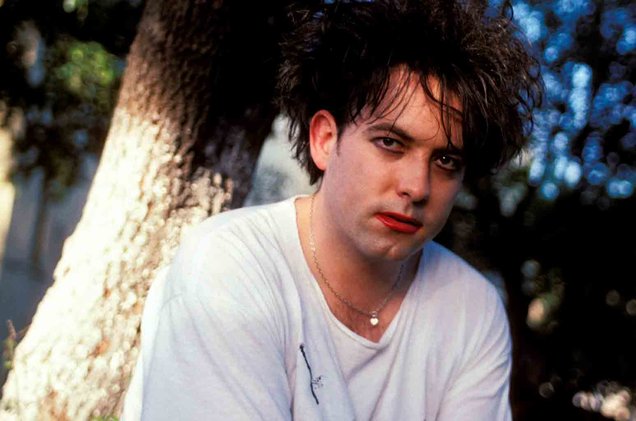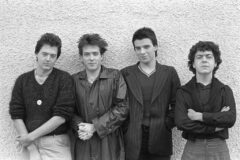Robert Smith has been making music with the Cure since the goth-rock band formed in 1976 – and in 41 years’ time, his group has given us quite an extensive body of work (including 13 albums, 4 EPs and numerous compilations). His classic songs and his eccentric image have captivated audiences on both sides of the Atlantic, making the Cure one of the most internationally successful acts in alternative rock history.
Over the course of his illustrious four-decade career, Smith has performed with his idol David Bowie, appeared as a superhero version of himself in an episode of South Park, and reportedly even inspired the look of Tim Burton’s 1990 cult classic Edward Scissorhands. His favorite cover of a Cure song is Dinosaur Jr.’s “Just Like Heaven.” Revisit 15 of the band’s classic tracks below.
“10:15 Saturday Night” (1979)
“Waiting for the telephone to ring.”
The first track off The Cure’s debut album (aka “that drip drip drip one”) was written when Smith was 16 years old and the band was still called Easy Cure (1976-1978). In his book, Never Enough: The Story of The Cure, author Jeff Apter shares that after Polydor’s Chris Parry heard the demo of “10:15 Saturday Night” in 1978, he signed the trio to his own label, Fiction Records. In the liner notes of the 2005 reissue of Three Imaginary Boys, Smith shares the song was composed at his kitchen table “watching the tap dripping, feeling utterly morose. My evening had fallen apart and I was back at home feeling very sorry for myself.”
“Boys Don’t Cry” (1979)
“I would tell you that I loved you, if I thought that you would stay.”
Another song from the Cure’s demo that caught the attention of Polydor’s Chris Parry. In an interview with Rolling Stone, Smith shared, “The pop songs like ‘Boys Don’t Cry’ are naive to the point of insanity. But considering the age I was and the fact that I had done nothing apart from go to school – no real life experience, everything was taken from books – some of them are pretty good.” Smith also referred to the single as “an attempt at a ’60s pop song.” The song, credited as breaking the band, was re-released in 1986, and peaked at No. 22 on the U.K. singles chart.
“Jumping Someone Else’s Train” (1979)
“If you pick up on it quick, you can say you were there.”
Urban Dictionary defines jumping someone else’s train as “copying someone else’s style, or just agreeing with what they say and believe to fit in.” That makes sense, since Smith revealed the song is about the ‘mod’ fashion revival of the time. Press play on the video, and jump a train from London Victoria to Brighton station.
“A Forest” (1980)
“I’m running towards nothing.”
Apter referred to “A Forest” as “the definitive early Cure mood piece, while Smith described the song as “a childhood dream/nightmare that came true with adolescence.” He also noted, “It was probably the turning point when people started listening to the group and thinking we could achieve something, including me.” “A Forest (Tree Mix)” appears on the Cure’s 1990 remix album Mixed Up, providing an additional minute of gorgeous new-wave atmospherics, and the perfect soundtrack for getting lost in a forest.
“Let’s Go To Bed” (1982)
“It’s just the same, a stupid game.”
Smith told Apter, “When I wrote ‘Let’s Go to Bed,’ I thought it was stupid. It’s a joke. All pop songs are basically saying, ‘Please go to bed with me.’ So I’m going to make it as blatant as possible, set it to this cheesy synth riff – everything I hated about music at the time. Suddenly, we’re getting 15 plays a day on American radio.” It peaked at No. 44 on the U.K. singles chart.
“The Walk” (1983)
“In an instant I remembered everything.”
In his book, Cured: The Tale of Two Imaginary Boys, Tolhurst set the record straight about rumors the band was inspired by New Order‘s “Blue Monday,” pointing out that “The Walk” was recorded before “Blue Monday” was released. In 1983, Robert Smith and Lol Tolhurst came on MTV to promote “The Walk,” resulting in an incredibly awkward discussion with original VJ Nina Blackwood. It peaked at No. 12 on the U.K. singles chart.
“In Between Days” (1985)
“Yesterday away from you, it froze me deep inside.”
“In Between Days” was the Cure’s first single to hit the Billboard Hot 100 chart, peaking at No. 99. Jeff Apter called it “a candy-coated treat with a poisonous center,” since Smith managed to make his despair — “yesterday I got so old, I felt like I could die”– sound like a celebration. In a video interview, Smith revealed, “We wanted to make a video that portrayed us as we are, without looking glamourous.”
“Close to Me” (1985)
“I wish I’d stayed asleep today.”
At the 1991 Brit Awards, the Cure won Best British Group, and “Close to Me” (a five-year-old song about claustrophobic pursuits of the night) was nominated for Best Video. In 1986, the song originally peaked at No. 32 on what was then Billboard‘s Hot Dance/Disco — Club Play chart (now Dance Club Songs). Its returned to the charts in 1991 came thanks to dance music icon Paul Oakenfold‘s “Closest Mix,” from the band’s 1990 remix album, Mixed Up. The remix peaked at No. 97 on the Hot 100 chart and No. 44 on the Hot Dance Music – 12-Inch Singles Sales chart.
“Why Can’t I Be You” (1987)
“You’re so gorgeous, I’ll do anything.”
Smith described the music video to the band’s Kiss Me Kiss Me Kiss Me lead single as a “drunken schoolgirl in gay sex orgy,” and Apter called it “some of the most poorly choreographed dancing ever seen on MTV.” As for Director Tim Pope, it was the video he always wanted to make: “The Cure, dancing!” At 1:10 in, notice the clever way the band forms “Y C I B U” with a mouth representing “can’t.”
The title of the song is based on a true story. “I was in the middle of a tense discussion and these people around the table were looking at me as if I was going to make some ground breaking revelations,” Smith related. “And I thought to myself ‘good god, why can’t I be elsewhere?’ I would’ve traded with anyone.” “Why Can’t I Be You” peaked at No. 54 on the Hot 100 chart.
“Just Like Heaven” (1987)
“I promise that I’ll run away with you.”
In an interview with Blender, Smith revealed, “The song is about hyperventilating — kissing and fainting to the floor.” His then-girlfriend (and later wife) Mary Poole appears in the video — “Mary dances with me in the video because she was the girl [in the song], so it had to be her,” Smith explained. The opening line (“show me, show me, show me how you do that trick”) refers to his childhood memories of mastering magic tricks, but “on another [level], it’s about a seduction trick, from much later in my life.” It peaked at No. 40 on the Hot 100 chart, marking the band’s highest hit on the chart at that time.
Bonus: Watch the making of the song’s classic gloomy-skied video.
“Hot Hot Hot!!!” (1988)
“I left that house on fire and I never went back.”
Smith revealed the song is about three strange sexual experiences: “In the basement of a club, on a ferry and at home in my bedroom. Lightning striking was an analogy.” He also described the song as “espousing the general delights of altered states of consciousness.” It peaked at No. 65 on the Hot 100 chart. All Music points out that the Tim Pope-directed video “is completely and intentionally ridiculous.” The clip saw the band’s go-to director misinterpreting Smith’s intentions for the visual somewhat, with the frontman later explaining: “I told [director] Tim Pope I wanted us to look like a lowdown funky soul band. He translated ‘lowdown’ as ‘dwarf’ and ‘soul band’ as ‘black-and-white.’ Polydor said it wouldn’t get shown. It didn’t.”
“Love Song” (1989)
“I will always love you.”
If it wasn’t for Janet Jackson, the Cure might have actually found themselves on top of the Hot 100 in late 1989. Instead, they had to make do with their biggest chart hit to date peaking as a runner-up. In an interview with Rolling Stone, Smith revealed, “I wrote “Love Song” for Mary, my wife, as a wedding present, and I put it on the album to be romantic. I thought it was the weakest song on there, and suddenly it went to No. 2 in America. I thought, ‘Of all the songs I’d written, this is the one that kind that cracks through.’ It was quite disappointing.”
“Fascination Street” (1989)
“Let’s move to the beat like we know that it’s over.”
The Bourbon Street-inspired track became the band’s first No. 1 on Billboard’s then-Modern Rock Tracks (now Alternative Songs) chart, where it stayed on top for seven weeks. It also peaked at No. 46 on the Hot 100 chart. In an interview with Select, Smith said, “I was getting ready to go there [Bourbon Street] and thought: ‘What the f–k do I think I’m going to find?’ It’s about the incredulity that I could still be fooled into looking for a perfect moment.”
“Lullaby” (1989)
“The spiderman is having me for dinner tonight.”
It seems Smith’s uncle used to torment his nephew with tales of a boy-eating creature know as “the spiderman.” In an interview with NME, director Tim Pope said that the song eludes to Smith’s drug-filled past: “On one level, there is this stupidity and humour, but beneath that there are all Smiffy’s psychological obsessions and claustrophobia.” Smith’s real-life arachnophobia comes to life in the visual, which won Best Video at the 1990 Brit Awards. The song is the band’s only top 5 hit in the U.K. to date.
“Burn” (1994)
“Every night I burn, every night I scream your name.”
The underrated “Burn” was written specifically for the sleeper hit flick The Crow, whose soundtrack hit No. 1 on the Billboard 200 chart a few weeks after the film opened at No. 1 at the box office. The song wasn’t performed live until 2013, when the band surprised fans at New Orleans’ Voodoo Music & Arts Experience. Tim Pope, who helmed numerous Cure videos, also directed the movie’s 1996 sequel, The Crow: City of Angels.
This story originally ran on Billboard.





